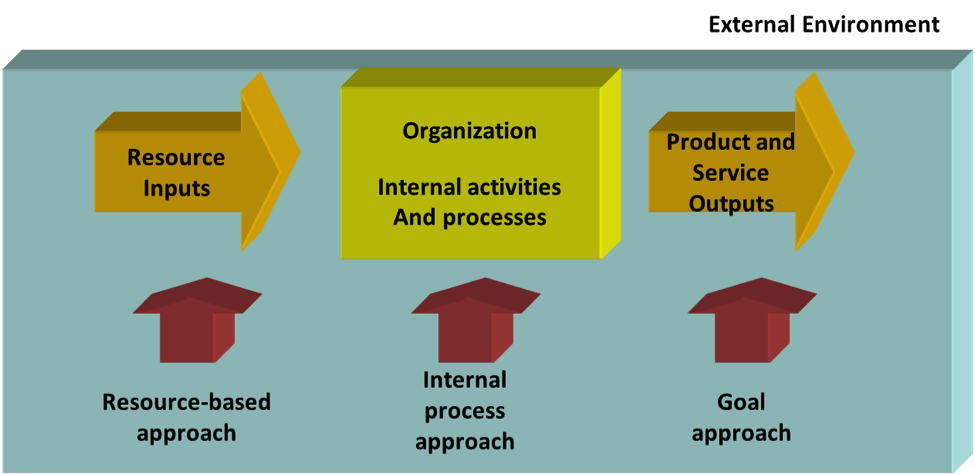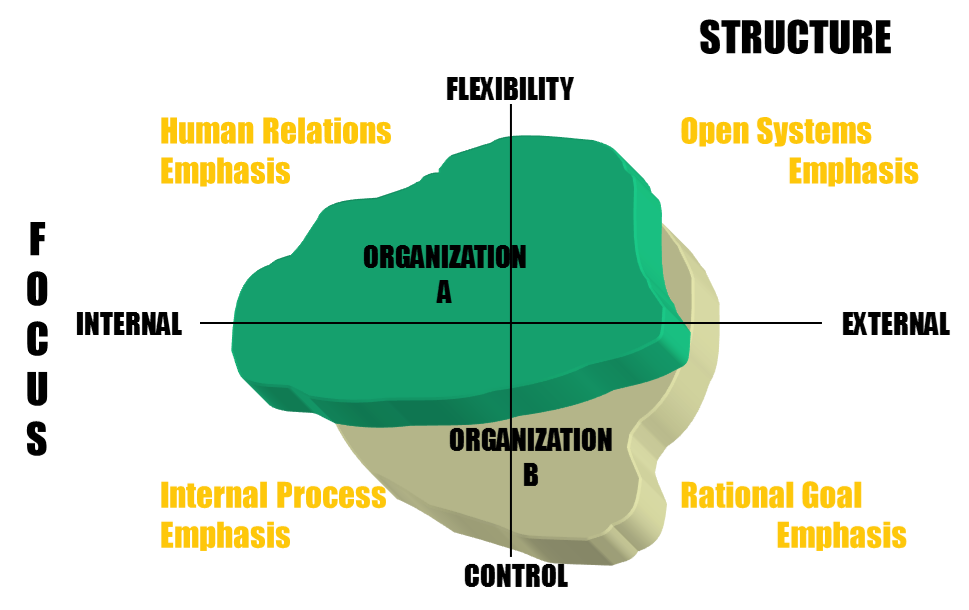Main Content
Lesson 2: Overview of Organization Development
Organizational Effectiveness: The Ultimate Goal for Change
Increasing organizational effectiveness is the ultimate goal for any organizational change (this is the answer to the previous section–why organizations change).
Organizational effectiveness is different from efficiency. Efficiency focuses on the conversion of inputs to outputs (e.g., output: input ratios), while organizational effectiveness, based on some scholars, is the degree to which an organization realizes its multiple goals. In a way, efficiency is doing something right, while effectiveness is doing the right thing.
Goals and effectiveness are certainly related; however, effectiveness is more complicated than merely achieving goals. For most of organizational scholars, the term effectiveness is quite difficult to define and is used in a variety of ways. Whether an organization is effective or not may depend on who is asking the question. This fuzziness leads to a variety of ways of measuring whether or not an organization achieves effectiveness. If someone claims that an organization is effective, then you should be very critical on what measures he/she used to measure the effectiveness.

Figure 2.1. Measuring Organizational Effectiveness
In general, the following ways are used to measure whether an organization is effective:
- Resource-Based Approach
The resource-based approach evaluates the ability of the organization to obtain valued resources from the external environment. Thus, it looks at the input side of the transformation process. This approach is useful when other indicators of performance are difficult to obtain. Indicators of system resource effectiveness include dimensions such as bargaining position, ability to correctly interpret properties of the environment, maintenance of internal day-to-day activities, and the ability to respond to environmental changes. A shortcoming of this measurement is the overemphasis on acquisition of resources rather than on their utilization. Thus, most organizational scholars believe that while acquiring resources is necessary, this alone does not give us a comprehensive picture of organizational effectiveness.
- Internal Process Approach
The internal process approach evaluates effectiveness by examining internal organizational health and economic efficiency. Here, some scholars use efficiency as the indicator for effectiveness. And others use the evaluation of human resources as the indicator for effectiveness. Indicators of effectiveness include strong corporate culture, team spirit, trustful communication, decision making near sources of information, undistorted communication, managerial rewards for performance, and interaction between the organization and its parts. There are, in turn, two different ways to look at internal effectiveness.- Efficiency: An organization is effective to the extent that it maximizes outputs with respect to the costs of inputs and the costs of the transformation of those inputs into outputs.
- Emotional or affective health: An effective organization is one where workers are happy and satisfied.
- Goal Approach
The goal approach defines effectiveness in terms of “if,” and “how well,” an organization accomplishes its goals. It measures effectiveness by evaluating the extent to which operative goals are achieved. For this to work, goals must be measurable. It is more productive to measure effectiveness using operative goals than using official goals which are more abstract and difficult to measure. The goal approach is used because output goals can be readily measured after issues of multiple goals and subjective indicators of goal attainment are resolved.
Managing multiple and conflicting goals is necessary when different managers champion different goals, or when the focus of managers of different goals created the desire to serve different environmental demands. Therefore, effectiveness often cannot be assessed by a single indicator.
One problem with this approach is, if the goals are ill-defined, complex, or inappropriate, the mere attainment of these goals does not guarantee effectiveness. A second problem is, if the goals do not represent the diverse interests of important stakeholders, the organization may find itself in trouble. Thirdly, many times the meeting of one goal means that a conflicting goal cannot be achieved.
- Stakeholder Approach
Performance from the stakeholders’ perspective is yet another way to assess effectiveness. According to this perspective, organizations are effective to the extent that key groups are minimally satisfied. That is, if all the stakeholders are satisfied with the organization, then it is effective. Because stakeholders have conflicts, this approach forces the difficult issue of whose claims are the most important, and most of time, it is indeed difficult to prioritize different stakeholders’ demands.
As can be seen, there is no clear-cut way to assess effectiveness. Each of the above approaches gives only a partial view. There is not one best approach to effectiveness; rather, we must determine why we want to measure effectiveness, the appropriate time frame, and then apply the proper model to the type of organization in question. Based on this understanding, two additional perspectives that try and synthesize some of the earlier approaches have been developed.
- Contradictions Model
This model argues that the idea of trying to characterize a whole organization as totally effective is problematic. Four central assumptions drive the model.- Organizations face complex environments that place multiple and conflicting demands and constraints on them. It may not be possible to meet all of these conditions.
- Organizations have multiple conflicting goals. It is impossible to maximize achievement of all goals.
- Organizations face multiple internal and external stakeholders, and it may be impossible to meet all of their conflicting demands.
- Organizations must manage multiple and conflicting time demands. There may be a tradeoff between satisfying short-term and long-term demands.
This model does not suggest one best way of assessing effectiveness; rather, it makes us cognizant of these potential contradictions.
- Competing Values Model
The essential point of the competing values model is that no single measure of effectiveness is, by itself, satisfactory. This approach recognizes that managers may emphasize different indicators of performance and tries to balance a concern with various parts of the organization rather than focusing on one part. Two values can be used to categorize four approaches of effectiveness: Organizational focus is whether issues internal or external to the firm are valued. Organization structure is the emphasis on either flexibility or stability. The combination of these two dimensions yields four distinct approaches.- Human Relations Model: Combines internal focus and flexible structure with management's primary goal being employee development.
- Open Systems Model: Combines an external focus and flexible structure, with management's primary goals being resource acquisition and growth.
- Internal Process Model: Reflects the values of internal focus and stability, with management's primary goal being to maintain the status quo.
- Rational Goal Model: Focuses on stable structure and external environment with management's primary goals being productivity, efficiency, and profit.

Figure 2.2. Categories of Effectiveness
